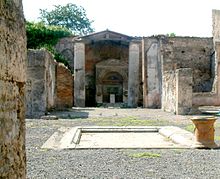Nymphaeum

A nymphaeum ( Greek Nymphaion , Latin Nymphaeum ) is a nymph sanctuary , usually built over a well or spring . Most nymphaea are semicircular buildings in column architecture, sometimes multi-storey. In Hellenism and Roman antiquity , the term was transferred to spring and well houses as well as representative urban buildings with water basins and multi-storey column facades that stood at the mouth of an artificial water pipe.
There are also nymphaea in the form of natural or man-made grottos. Nymphaea in the form of central buildings served as the basis of early Christian baptisteries .
One of the most famous nymphaeans of antiquity was built in Olympia by order of Annia Regilla . In addition to supplying water to the Altis, it served to glorify the family of Herodes Atticus , Annia Regilla's husband.
In modern times, caves and nymphaea became an important part of the architecture of villas and gardens . Notable examples are:
- The nymphaeum of the Villa Barbaro by Andrea Palladio in Veneto (1554).
- The Fontana di Trevi in Rome (1732–1762).
- In early classicism , Friedrich Wilhelm von Erdmannsdorff rebuilt a nymphaeum in the Wörlitzer Park in 1767/68 with the grotto of the Egeria (today part of the Dessau-Wörlitz Garden Realm as a UNESCO World Heritage Site ).
- The nymph bath in the Dresden Zwinger
literature
- Lexicon of antiquity . 10. through and exp. Edition VEB Bibliographisches Institut Leipzig, Leipzig 1990. ISBN 3-323-00026-9
Web links
Individual evidence
- ↑ Ulrich Sinn : Olympia. Cult, sport and festivals in antiquity (= Beck'sche series. 2039). Beck, Munich 1996, ISBN 3-406-40339-5 , p. 92 ff.
